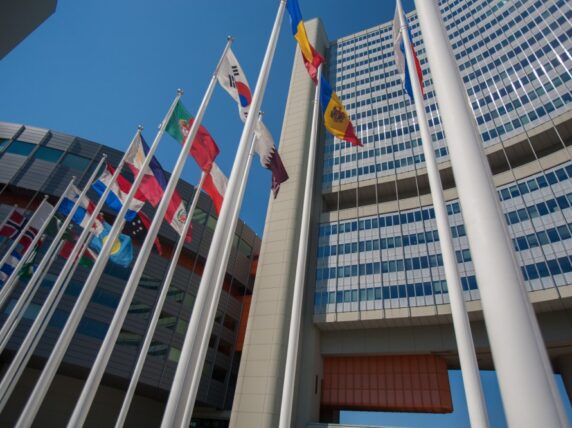What came out of the COP25 climate talks – and what it means for those most affected by climate change
COP25 in Madrid was supposed to be a technical climate change summit, setting the scene for the more political COP26 hosted by the UK next year in Glasgow.
But it ran over time more than any of the past 25 years of climate talks, whilst having less to show for it. And it now leaves a diplomatic mountain to climb for the UK Presidency.
The talks took place against a backdrop of spiralling impacts from Mozambique to Guatemala to the Philippines, as the climate crisis continues to take grip around the world. They also took place in a context of unprecedented public pressure for climate action. Spain saw their largest environmental march ever. And youth, indigenous people and civil society brought the urgency happening outside into the venue.
At one point, hundreds of activists were temporarily shut out of the talks for protesting against the big emitters, arguing they should “step up and pay up”. When the talks hit a low in the last night of the negotiations, civil society representatives organised their own “people’s plenary”, denouncing the lack of ambition shown elsewhere at the conference.
So what came out of COP25, what does it mean for those most affected by climate change, and what are the implications for Glasgow?
Mitigation ambition – ratcheting up national emissions reduction pledges
The climate crisis is already making life unbearable for millions of the world’s poorest people. Yet the collective emissions reduction pledges currently on the table are woefully inadequate, and will lead to catastrophic levels of heating. So COP needed to agree, loud and clear, that countries would enhance their national climate action plans (NDCs) next year, before the Paris Climate Agreement deadline.
Despite blocking attempts from powerful polluters, enough of a signal was agreed, and a growing alliance of mainly vulnerable countries has pledged to put forward enhanced plans. Emerging economies, concerned that feet dragging by rich countries to date leaves them picking up an unfairly large tab, focused on holding these rich countries to account for the non-delivery of their pre-2020 commitments on emissions and finance.
In the middle of the talks, the EU provided momentum by agreeing to reach ‘net’ zero emissions by 2050, whilst promising to bring forward a proposal to strengthen their 2030 target next summer (which the UK will, for the moment, still be part of).
Loss and damage – developing countries came together to demand new and additional funding for climate harms
Loss and damage was at the centre of this COP. These are the kind of climate impacts it is not possible to adapt to. Poorer nations spoke with one voice to demand new and additional funds to help them recover and rebuild from climate shocks – including by rehoming communities which become uninhabitable, and land unfarmable.
Yet COP25 did not establish a new funding mechanism for loss and damage. Instead, countries agreed to start a conversation about funding and to create a new expert group to advise on the issue by COP26. They also asked the Green Climate Fund – the main multilateral fund through which rich countries channel climate finance – to take up the matter.
Subscribe to our newsletter
Our weekly email newsletter, Network News, is an indispensable weekly digest of the latest updates on funding, jobs, resources, news and learning opportunities in the international development sector.
Get Network NewsNo agreement was reached on governance, and so this will resurface for COP26. The stance of the US in particular – which amounts to turning their back on those already bearing the costs of climate harms – was likened by the Tuvalu negotiator to a “crime against humanity”.
Finance
In Madrid, developed countries pledged almost $90 million in new funding to the Adaptation Fund, and made a couple of additional pledges to the Green Climate Fund. Overall, developing countries were unhappy with what they saw as a “regression” in the recent replenishment of the Green Climate Fund compared to five years ago – and called for laggard contributors to top-up their pledges.
The final agreement did not include calls for a status report on the delivery of the $100bn climate finance for developing countries, due next year, and stopped short of calling for an overall “scaling up” of finance by developed countries. This issue will come back with a vengeance as talks on the post-2025 finance goal, a progression on the current $100bn pledge, are due to start formally in Glasgow during COP26.
Article 6 – what next for global carbon trading?
COP25 was the site of successful resistance by progressive countries and voices against bad carbon market rules, which would have contained loopholes so large they would have derailed efforts to keep 1.5 degrees in sight, whilst risking harm to communities in the absence of human rights safeguards. Countries agreed that no deal was better than a bad deal, which means this is another major issue that will roll over to Glasgow, where it will likely take up an enormous amount of bandwidth.
Aside from the sizeable loopholes being asked for by Brazil, Australia and others, key issues include whether the scheme should go beyond a simple zero-sum offsetting mechanism for companies and governments, to actually help lower overall emissions. Plus, whether a share of revenues from carbon trading will be a much-needed source of predictable funding for the Adaptation Fund.
Category
News & viewsThemes
Politics



